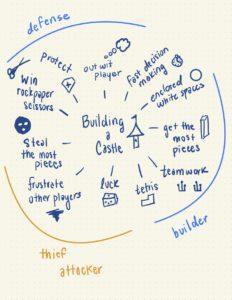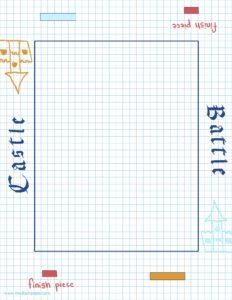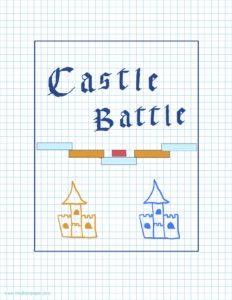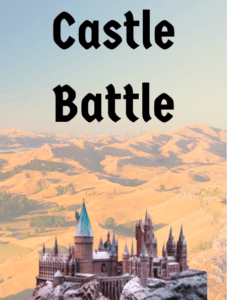Artist’s Statement
Patchwork. Chess. Tetris. Rock-Paper-Scissors. Civilization. These are the games that brought us inspiration to create Castle Battle. Players are gratified by building the largest castle that they can but must do so by cleverly choosing roles and outwitting their opponent. We started with block pieces to resemble a tetromino-like game but then decided to add a rock-paper-scissors component by adding roles – builder, thief, attacker, and defender. These roles add more interplayer interactions and surprises. Although players may be deceived that this game is purely based on luck, players can still navigate the random components of the game by strategically placing down blocks and thwarting other players. Furthermore, a medieval theme comes into play through the concept of building a castle and the kinds of roles players take on. This decision was so that we can add more story and narrative to the game and make it something more than just putting down blocks on the board. Lastly, Castle Battle is flexible where players can play 2v2, 4v4, and so on by creating two even teams. One can make the game even more fun and fast-paced by adding a time limit on the decisions playersmake during each round. We encourage players to make this game their own!
Concept Map

Initial Decisions
Initially, we designed our game to be a silent and cooperative game in which players use tiles to complete the grid. We planned the game to emphasize sensation, challenge, fellowship, and some submission. We wanted the game’s values to be cooperation and building friendship by learning how to communicate silently.
The formal elements of the initial version are as follows:
The objective of the game was construction – complete the 10 * 10 board with the given blocks. We expected to have it be a 2 ~ 5 player game. The initial mechanics of the game was that each player receives a certain number of cards and each player takes turns putting down at least 2 pieces to complete the board in perfect silence. We also considered putting in more specific limitations on how players can put down the blocks and where they should go to adjust the difficulty level. The procedure of the game was going to be that each player puts down blocks corresponding to their cards in spots that they like on the board to benefit everyone and redraw cards to have the same number of cards in their hand as they did at the beginning of their turns. The resources of the initial version were blocks as once players ran out of blocks or blocks that they could putdown, the game was over. The conflict of the game was an obstacle as silence would hinder being able to complete the board.
Playtest Iterations
Testing and Iteration History
First playtest: Nicole, Nicholas, Star, & Mike C.
- Zero communication, 5 cards in hand
- Paper tiles are really easy to mess up, hard to fix on the square
- More like Tetris at the beginning, isn’t that hard
- Gets harder as we approach the corners and run out of pieces
- Can view the amounts of unique tiles as they run out
- People start to make wacky moves as the game goes on to make it harder on other people
- It’s hard to tell whether the board is filled because the paper pieces move easily
- Seems too easy, needs more limitations
Second playtest: Nicole, Nicholas, Star, & Mike C.
Playing with limitations:
Three cards in your hand
- One player touches diagonals
-
-
- more challenge playing at corners
-
- One player plays three but can’t touch
-
-
- Gets hard for not touching all pieces on the board versus the three pieces not touching
-
- One player only puts one piece at a time
-
-
- Not a limitation
-
- One player puts two pieces together and then plays
-
- Amusing
Third playtest: in class (4/12) with 5 players
Each player starts by putting one piece on the board without touching the edges or other players’ pieces
During each turn, players draw 2 cards and attach the two blocks together before putting them on the board
- There was confusion regarding the rules
- Players thought they had to put their new pieces attached to their previous pieces
- They said it wasn’t very engaging
- Someone said, “that’s it?”
Fourth playtest: Kai S. and Kyle N.
NEW version Castle Battle
Kai:
- Loved the concept <3 / medieval theme
- Reminded him of dot.io games
- Would make it more fun it was fast-paced or multiplayer?
- Found it fascinating that Kyle was trying to “read him” and determine what his next move would be
- “It felt like 5 minutes” even though it took about 30 minutes
- Solution: takes a long time if not timed – add a timer for making decisions?
- Was confused about if there was midline separating the board in half
- Kyle put his pieces on the other side of the board
- Kai then put his pieces in Kyle’s territory
- Solution: better instruction -> “defend your corner”
Kyle:
- Thought it was fun!
- The rock-paper-scissors component (choosing roles 3..2..1!) was his favorite part of the game
- He looked forward to this part especially
- Yelling out your role and then winning/losing was exciting to him
- Still ambiguous about what a finished castle
- Solution: better instruction -> “defend your corner and get most enclosed white spaces”
- Consequently, didn’t know where to put the pieces
- Wished castle-building was more attached to the roles
- After choosing roles, felt like they didn’t know what to do with castle building
- Solution: Connect to the premise more? -> attacker steals stone from the castle
Fifth playtest: Nicole and Mike C.
NEW version Castle Battle
- During this playtest, we played three different rounds, making little modifications each time
- The modifications were:
- the first three blocks cannot be in the same row or column
- If a player defends successfully, they get to put down a block
- Used a d4 rather than a d6 to balance luck vs skills and give builders less power
Mike:
- Enjoyed learning the roles
- Also reminded him of dot.io games
- Thought it was too luck-based
- Had trouble understanding the definition of castles, but once understanding enjoyed experimenting with different strategies
- Thought the game could become routinized quickly
- Really liked the theme, would’ve loved to see pieces designed to fit the theme (i.e. if blocks looked like woods or stones)
- Asked if our goal is to defend our corner
- Had a lot of fun and was enthusiastic about trying multiple rounds to learn the game well

Design Mock-up




